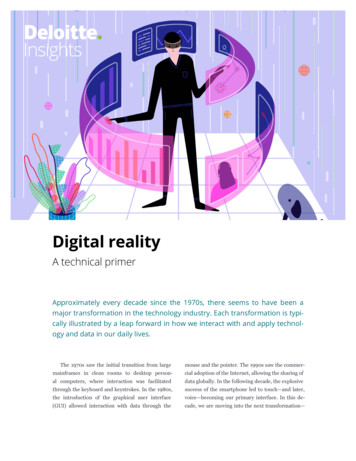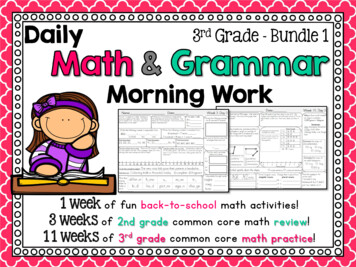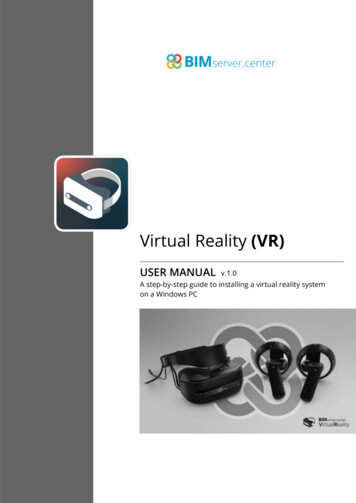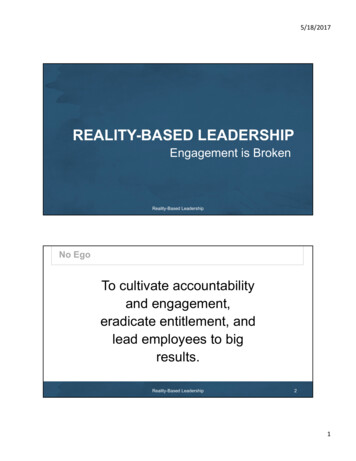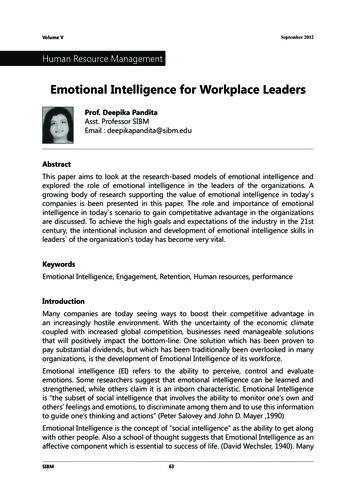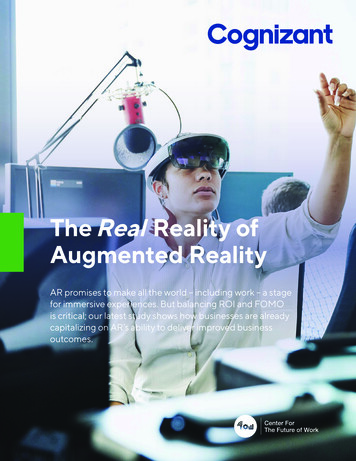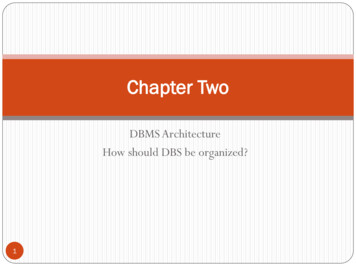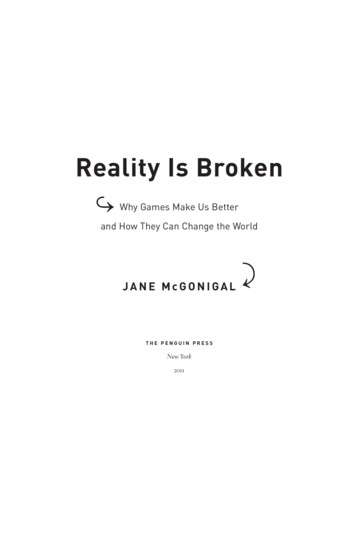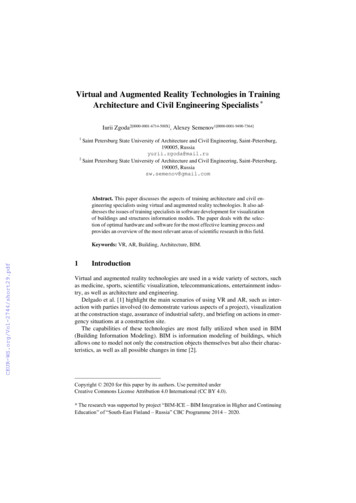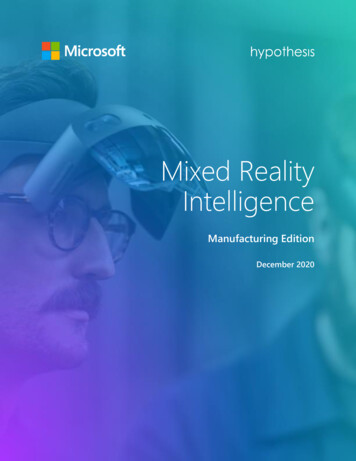
Transcription
Mixed RealityIntelligenceManufacturing EditionDecember 2020
Table of ContentsBackground04Methodology05Who We Talked To – October 202006Things To Know About Mixed Reality07Mixed Reality in Manufacturing08Final Thoughts21Detailed Research Objectives & Audience Recruit22
Learn MoreTo learn how mixed reality solutions can supportand enhance your business, or to connect with amixed reality specialist, please visithttps://aka.ms/MixedRealityDesk. Hypothesis Group 2020. Microsoft 2020. All rights reserved. 10/20
BackgroundAs companies across the world begin employing immersive technologies todrive efficiencies, Mixed Reality is poised to change the way businessesoperate. Mixed Reality blends the digital and physical world by overlaying 3Ddigital objects onto the user’s physical world, offering a way for users tointeract organically using head-mounted devices (HMDs). Located at thecenter of the virtuality continuum, the capabilities of Mixed Reality render ituniquely positioned to transform the workplace as we know it.Microsoft has been at the forefront of the immersive technology market and atrailblazer in Mixed Reality, innovating in both hardware and software to offercross-platform Mixed Reality solutions. With the introduction of HoloLens, thefirst untethered Mixed Reality headset designed with business use cases inmind, Microsoft established itself as a leader in the Mixed Reality space andvalidated the enterprise value of this nascent industry by partnering withprominent entities in contracts worth up to half a billion dollars.In October 2020, Microsoft and Hypothesis embarked on an initiative to hearfrom IT and Business Decision Makers across three countries with the goal ofdeveloping a deeper understanding of how Mixed Reality is being utilizedacross three key industries: manufacturing, retail, and healthcare. This paperdeep dives into how manufacturing organizations are using and consideringMixed Reality technologies. While the primary data collected are quantitative,this report also illuminates customer stories that bring said data to life,providing a comprehensive picture of Mixed Reality use in the market today.Furthermore, this report also aims to uncover the ways in which Mixed Realitymay evolve in the future.4Mixed Reality Intelligence: Manufacturing Edition
MethodologyMicrosoft commissioned Hypothesis Group, an insights, design, and strategyagency, to execute the Mixed Reality Intelligence research.The Mixed Reality Intelligence Research occurred in October 2020, when a15-minute online survey was conducted with over 700 decision makersinvolved in mixed reality decisions at mid-market and enterprise companiesfrom a range of manufacturing, healthcare, and retail companies across theUS, Germany, and Japan.In addition, the research deep dives into customer stories from interviewsbetween Microsoft and mixed reality decision makers at enterprisecompanies around the world that use HoloLens 2.Manufacturing Customer Stories5Mixed Reality Intelligence: Manufacturing Edition
Who We Talked ToBDMs & ITDMsOctober 2020in Manufacturingwho work at mid-market orenterprise-size companies(500 employees)62%Familiar withMixed RealitySelf-stated &Pass a knowledge test95%Have influence/decision making poweron Mixed Realitystrategies84%in Mixed Realityadoption orevaluation87%Use or plan to useHMDs for MixedRealityFinal Audience6Mixed Reality Intelligence: Manufacturing Edition
Things To Know About Mixed Reality71The majority of manufacturing organizations are currently using MixedReality solutions via HMDs and usage is projected to grow in the next12-24 months. Mixed Reality is seen as a critical asset to organizations(97% agreement) among those who are currently using it or consideringit for the near future.2Implementation issues like integration and deployment prevent currentusers from adding new solutions to their portfolios. For prospectiveusers who are in the consideration stage, budget, timing, and lack ofknowledge are the largest barriers to adoption.3Manufacturing organizations are currently utilizing Mixed Reality mostfor Task Guides & Task Management solutions, with Design &Prototyping trailing closely. Usage of Mixed Reality for RemoteAssistance is lowest but projected to grow in the next year.4Over half of all manufacturing organizations expect a return of 30% ormore on average from their investment in Mixed Reality across TaskGuides & Task Management, Design & Prototyping, and RemoteAssistance solutions. Customer success stories from Lockheed Martin,Airbus, and L'Oréal demonstrate how HoloLens 2 solutions meet andexceed these industry expectations.Mixed Reality Intelligence: Manufacturing Edition
Mixed Reality inManufacturing
The Big PictureGiven the nascency of Mixed Reality, Manufacturing organizations find themselvesin various stages of implementation. Among those surveyed, north of 80% arecurrently using Mixed Reality products and solutions in some capacity, with morethan half reporting that these technologies have already been integrated intotheir business models; among current users, only 1-in-4 remain in the trial stage.That said, even those in the former group are relatively new to Mixed Reality: 2in-3 have been using the technology for less than two years. Of the countriesexamined, Mixed Reality usage is highest in Germany, where current userscomprise 91% of organizations surveyed. This number is lowest in Japan, whereonly 72% of organizations fall into this category, and is equivalent to the overallmean (81%) in the United States. (Exhibit 1)EXHIBIT 1. CURRENT VS. PROSPECTIVE USERS OF MIXED REALITY81%19%Prospective UsersPlan to use MR inthe next 12 monthsCurrent Usersof HMDsIncluding those trialing56%Currently usingproducts or solutions26%Trialing productsor solutions9Mixed Reality Intelligence: Manufacturing Edition
Across the board, current users agree that this emerging technology is critical totheir success. Crucially, Mixed Reality is seen as a solution for both today andtomorrow: users are nine points more likely to describe the technology as verycritical when assessing its future value as compared to the present. As a result, themajority of current users (65%) plan to increase their investment in Mixed Realityin the future, while the remainder expect to invest the same as they currently do;none of the organizations surveyed plan to invest less. (Exhibit 2)With users committed to their investments and optimistic about the future,adoption and trial of Mixed Reality is expected to increase. “We are already seeingsome improvements in productivity and we expect that will increase as we developnew processes,” predicts an IT Decision Maker in discrete manufacturing. “Thisshould be a net win for us.” Looking toward the future, growth in HMD volumeappears to be greatest among very large enterprises, who likely have more fundsto invest in headsets. While companies of all sizes anticipate increasing thenumber of Mixed Reality HMDs utilized by more than 50% in the next 12 months,the largest organizations—that is, those with at least 5,000 employees—expect tomore than double their HMD volume during the same time frame.EXHIBIT 2. MIXED REALITY CURRENT VS. FUTURE VALUE10 9Very critical60%Somewhat critical39%Not that critical/Not critical at all1%29%2%Current ValueFuture ValueMixed Reality Intelligence: Manufacturing Edition69%
Mixed Reality BarriersWithin Manufacturing, prospective and currentMixed Reality users cite distinct barriers to usingthe technology or using it more, respectively.For current users, implementation challengesare top of mind; the difficulty of integratingMixed Reality with legacy systems and issueswith timing and deployment are two of themost salient barriers for this group. Prospectiveusers, on the other hand, identify budgetary andtime constraints as their primary challenges.(Exhibits 3 & 4)While the principal concerns of these twogroups are quite distinct, similarities amongother top barriers reveal that both current andprospective users would benefit from additionaleducation and training on Mixed Reality.Participants cite a lack of knowledge about thetechnology as a top challenge, and additionalbarriers suggest that uncertainty around theimplementation of Mixed Reality are also salientroadblocks for both groups. Knowledge andtraining barriers are particularly high amongJapanese organizations, offering a possibleexplanation for their lower adoption rates ascompared to Germany and the United States.Furthermore, while German organizations likelyface fewer barriers given their proclivity forMixed Reality products and services, it should benoted that German users stand out in that theyare most inhibited by security and liabilityconcerns, neither of which surface as topbarriers when data from the three countries areexamined in tandem. (Exhibits 3 & 4)11Mixed Reality Intelligence: Manufacturing EditionEXHIBIT 3. BARRIERS TO USINGMIXED REALITY MORE (TOP 5)Top 5 Barriers For Current UsersToo complex to integratewith legacy systems28%Still in the process of implementingcurrent MR solutions24%Issues with timing and deployment23%Isn't a solution that meets our needs21%Don't know enough20%EXHIBIT 4. BARRIERS TO CURRENTLYUSING MIXED REALITY (TOP 5)Top 5 Barriers For Prospective UsersDon't have the budget31%Takes too long to implement29%Don’t know enough27%Don't have enough deployment training27%Unsure about scalability in organization27%
Task Guides and Task ManagementDeep Dive intoTask Guides and Task Management represent a primary use case for MixedReality in Manufacturing, as headsets are able to virtually display criticalresources like detailed guidelines, safety information, and lengthydocumentation that an employee needs to complete complex manufacturingtasks. Nearly half of all manufacturing organizations currently use Mixed Realityfor Task Guides and Task Management. (Exhibit 5)Lockheed Martin is a company on the cutting edge of this trend. LockheedMartin is utilizing HoloLens 2 for Task Guides and Task Management to build theOrion Spacecraft, the only spacecraft that can take humans into deep space.NASA contracted Lockheed Martin to oversee the manufacture and assembly ofthe spacecraft, which required finding workarounds to paper instructions ortablet screens that are cumbersome and prone to human error. Thus, LockheedMartin is using HoloLens 2 to allow workers to collaborate remotely and helpproduce higher quality spacecrafts at lower costs, in less time. Voice commandsguide workers through every step, with holographic instructions overlaid onrelevant parts during assembly.EXHIBIT 5. USAGE VS. CONSIDERATION OF MIXED REALITYFOR TASK GUIDES & TASK MANAGEMENT48%1234%Mixed Reality Intelligence: Manufacturing Edition18%
”The fact that wehaven’t had anyerrors across all ofthese activities isphenomenal.”Shelley PetersonPrincipal Investigator forAugmented & Mixed RealityLockheed MartinGiven the formidable challenge of balancingcost, production time, and quality when thestakes could—quite literally—be life or death,HoloLens 2 has allowed Lockheed Martin toelevate and prioritize all three of these factorssimultaneously. While most organizationsreduce human error by approximately 30% byusing Mixed Reality for Task Guides and TaskManagement, Lockheed Martin has foundeven greater success in this endeavor: sincefirst implementing HoloLens 2 in 2017, thecompany has experienced zero human errorsor rework requests. This improvement is quiteexceptional; building a spacecraft requiresmillions of tasks—each with zero room forerror—and Microsoft’s HoloLens 2 hasallowed Lockheed Martin to bring thisexpectation to fruition.USING HOLOLENS 2 FOR TASK GUIDES & TASK MANAGEMENT13Mixed Reality Intelligence: Manufacturing Edition
Beyond this vast improvement in quality, Lockheed’s integration of Mixed Realityfor Task Guides and Task Management has had far-reaching implications fortheir bottom line. With respect to cost, Lockheed is now saving 38 per fastener-and this is no small savings when a single Orion spacecraft has over 57,000 ofthem. Vis à vis production time, HoloLens 2 has reduced touch labor by 90%;what was previously an 8-hour shift can now be completed in 45 minutes. Whilethe majority of organizations prioritize increasing employee performance andreducing human error over accelerating task completion, Lockheeddemonstrates that these outcomes are not mutually exclusive and in fact, can gohand in hand.Of the organizations not currently using Mixed Reality for Task Guides and TaskManagement, a majority (65%) are considering implementing it in the future. Assuccess stories like Lockheed Martin’s continue to proliferate, adoption of MixedReality is poised to continue growing. That said, the research identified someinternational asymmetries: Japanese organizations are less likely to use MixedReality for Task Guides and Task Management (34% vs. 48% overall), reflectingthe country’s lower adoption rates more generally. Because knowledge andtraining barriers are particularly high in Japan, it is likely that increased educationaround the ROI of Mixed Reality for Task Guides and Task Management couldincrease interest in this market.LOCKHEED MARTIN’S ORION SPACECRAFT14Mixed Reality Intelligence: Manufacturing Edition
Design and PrototypingDeep Dive intoLike Task Guides and Task Management, Design and Prototyping represents akey Mixed Reality use case within Manufacturing. In Mixed Reality, 2D designmodeling files are converted to high quality 3D digital replications thatemployees can interact and interfere with via motion control. This allows teamsto quickly iterate and collaborate on new product designs and assess whethertheir designs are fit for industrialization. Similar to Task Guides and TaskManagement, almost half of all manufacturing organizations currently use MixedReality for Design and Prototyping. (Exhibit 6)Airbus is a company leading the way here by leveraging HoloLens 2 for Designand Prototyping solutions to meet their ambitious production goals. Airbus built10,000 aircrafts in its first 40 years and aims to build 20,000 more in the next 20.To do this, the company needs to deploy cutting-edge tools and technologies toaccelerate production and find new ways of working. Airbus is using MicrosoftAzure Mixed Reality and services like Azure Spatial Anchors and Azure RemoteRendering with HoloLens 2 to expedite aircraft design, and manufacture,facilitate collaboration, and change how complex ideas are communicated.EXHIBIT 6. USAGE VS. CONSIDERATION OF MIXED REALITYFOR DESIGN & PROTOTYPING45%1532%Mixed Reality Intelligence: Manufacturing Edition23%
USING HOLOLENS 2 FOR DESIGN & PROTOTYPINGLike Lockheed Martin, Airbus was among thefirst major manufacturing organizations toidentify the potential for Mixed Reality toincrease production speed while simultaneouslyprioritizing quality and safety, and has beenpartnering with Microsoft on this front since2015. Jean-Brice Dumont, Executive VicePresident of Engineering at Airbus, explains that“[Airbus’s] challenge in the coming years is tomanufacture more aircrafts faster, and for thatwe need to enable our workers to be muchbetter equipped and to be much more effectivein what they do.” Microsoft Mixed Realitytechnology, he believes, is the solution thatmeets the moment.16Mixed Reality Intelligence: Manufacturing Edition“Mixed Reality can help usto increase quality, safety,and security. The level ofhuman error is significantlyreduced, and in aerospace,increased quality isincreased safety – andneedless to say, securitygoes with that.”Jean-Brice DumontExecutive Vice President of EngineeringAirbus Defense and Space
Among organizations currently using Mixed Reality for Design and Prototyping,more than 3-in-5 report an ROI of 30% . For Airbus, these returns have beenparticularly salient: with HoloLens 2 solutions helping Airbus designers virtuallytest their designs to see if they are ready for manufacture, the company has seenthe process accelerate by 80%. Beyond these already-measurable improvements,Airbus expects to increase efficiencies of complex tasks during assembly by 30%while simultaneously increasing quality, safety and security. They have alreadyidentified more than 300 use cases for Mixed Reality in an effort to utilize thistechnology to its full capacity.Of the organizations not currently using Mixed Reality for Design andPrototyping, slightly more than half (58%) are considering implementing it in thefuture. In considering whether to implement Mixed Reality for Design andPrototyping, organizations are primarily concerned with accelerating projectinnovation and design validation. As success stories like Airbus’s continue tocirculate throughout the industry, the potential for Mixed Reality to supportthese ROI expectations will become increasingly clear.AIRBUS FLEET17Mixed Reality Intelligence: Manufacturing Edition
Remote AssistanceDeep Dive intoBeyond facilitating and streamlining on-site tasks, the Manufacturing industryhas begun employing Mixed Reality to allow employees to be two places atonce. Remote Assistance implemented via Mixed Reality connects remoteemployees to collaborate with each other by streaming real time, 3D videos ofwhat they are working on. Experts anywhere in the world can conduct routineinspections and audits, deploy new equipment, or assist first line workers in newand critical tasks as needed, without having to physically travel to sites. RemoteAssistance remains the least prevalent use case of Mixed Reality examined here;still, 3-in-4 organizations surveyed are either current or prospective users.(Exhibit 7)In a prime illustration of this capability, L'Oréal is tapping into Dynamics 365Remote Assist via HoloLens 2 to connect remote experts to field technicians fromvarious locations. When a part breaks down on a machine, new equipment mustbe installed or an audit must be carried out; however, it is not always easy toexplain the process simply by phone, and bringing experts on site requires timeand resources. L'Oréal is now able to benefit from the expertise of those who arenot on site to carry out these operations in an efficient, cost-effective way.EXHIBIT 7. USAGE VS. CONSIDERATION OF MIXED REALITYFOR REMOTE ASSISTANCE38%1837%Mixed Reality Intelligence: Manufacturing Edition25%
”Thanks to this solution,we optimize inter-sitecommunication, weshare best practicesmore easily, and aboveall we benefit from theexpertise of the best.”Guillaume DuvergerManufacturing Excellence Project EngineerL'OréalUSING HOLOLENS 2 FOR REMOTE ASSISTANCE19Mixed Reality Intelligence: Manufacturing EditionIt is unsurprising that L'Oréal is leadingthe march for this under-utilized MixedReality application: the company hasbeen quick to embrace immersivetechnologies as a bridge to the futureand has been investing heavily in themsince 2012. As with other Mixed Realityuse cases, Remote Assistance is provingto be a worthy investment.Manufacturing organizations thatcurrently use Mixed Reality for RemoteAssistance estimate an averageimprovement of 31% in acceleratingissue diagnosis and resolution, andL'Oréal boasts even greater success at50% improvement in this respect.
For L'Oréal, time is everything, and the ability of Remote Assistance to transmitknowledge through space and time with the same precision as on-siteassistance has proven to be an incredible asset. “Saving time at L'Oréal is veryimportant,” explains Christian Georges, Manufacturing Excellence Director atL'Oréal. “We can now easily debug a situation and bring more comfort to ouremployees.” The attested capability of Remote Assistance to both expediteinspections/audits and accelerate issue diagnosis/resolution is key, as thesebenefits represent the two most desirable outcomes according toorganizations surveyed.Furthermore, Remote Assistance has benefits that extend beyond time savingsand convenience. Less travel means less employee fatigue and reduced CO2emissions, and inter-site communication can be optimized to share bestpractices more easily and connect to the best experts. L'Oréal has also seenimprovements in employee performance and morale, as well as their ability tomeet production deadlines.While Remote Assistance is the most under-utilized application of MixedReality of the three examined in this report, differences across the threenational markets suggest that the lower utilization numbers may be driven, inpart, by Japanese organizations. That is, Japanese manufacturers are less likelythan the group as a whole to currently use Mixed Reality for RemoteAssistance (28% vs. 38% overall).MICROSOFT MIXED REALITY AT L’ORÉAL20Mixed Reality Intelligence: Manufacturing Edition
Final ThoughtsAs immersive technologies continue to transform reality as we know it, MixedReality has emerged not as a VR-light but as a business tool in its own right.With its unique ability to blend the real and the digital, Mixed Reality offerssolutions that are as diverse as they are innovative, boasting use cases rangingfrom connecting remote experts with onsite technicians to enhanced assemblyprocedures. Ideas that felt like science fiction just a decade ago are now quiteliterally at our fingertips, and bold companies must think creatively about howthey can use Mixed Reality to differentiate themselves in an increasinglycompetitive digital marketplace.Across markets and industries, the benefits of implementing Mixed Realitytechnologies are vast, and three major themes emerge. First, by integratingdigital elements into real spaces, Mixed Reality reduces the constraints imposedby toggling between our physical environments and our screens. Second, MixedReality solutions offer distinctive advantages for education--be it corporate oracademic--by allowing students and trainees to develop hands-on experienceperforming tasks that could be detrimental or costly if executed by novices in areal-world context. Finally, Mixed Reality allows us to do something that waspreviously unthinkable: be two places at once. Infinitely more sophisticated thanvideo calling, Mixed Reality technologies can transport individuals who are milesapart into the same digital space, allowing them to interact with theirsurroundings and with one another as if the space between them had all butvanished. Particularly in the context of a global pandemic, this ability to emulatetogetherness feels indispensable.21Mixed Reality Intelligence: Manufacturing Edition
Detailed Research Objectives& Audience RecruitThe objectives of the research included:1. Understand the current Mixed Reality landscape including adoption, challenges, and outcomes 2. Explore current Mixed Reality projects, including how Mixed Reality isbeing used within key industries and customer stories 3. Quantify ROI expectations of decision-makers and demonstrate howROI is realized through customer stories 4. Uncover the ways in which Mixed Reality may evolve in the futureTo meet the screening criteria, Mixed Reality professionals needed to be:A business decision maker or IT decision maker at their company Employed full-time at a mid-market or enterprise-level company (500 employees or more) Ages 25-64 Familiar with Mixed Reality Involved in decision making for Mixed Reality technologies Adopting or evaluating Mixed Reality technologies Work in Manufacturing, Healthcare, or Retail industriesOf the 241 manufacturing Mixed Reality professionals interviewedfor the research wave in October 2020:100 Mixed Reality Professionals were interviewed in the US70 Mixed Reality Professionals were interviewed in Germany71 Mixed Reality Professionals were interviewed in JapanNote: Research was conducted during the global COVID-19 pandemic,which was at varying stages of escalation/containment Hypothesis Group 2020. Microsoft 2020. All rights reserved. 10/20
4 Mixed Reality Intelligence: Manufacturing Edition As companies across the world begin employing immersive technologies to drive efficiencies, Mixed Reality is poised to change the way businesses operate. Mixed Reality blends the digital and physical world by overlaying 3D digital objects onto the user's physical world, offering a way for .
